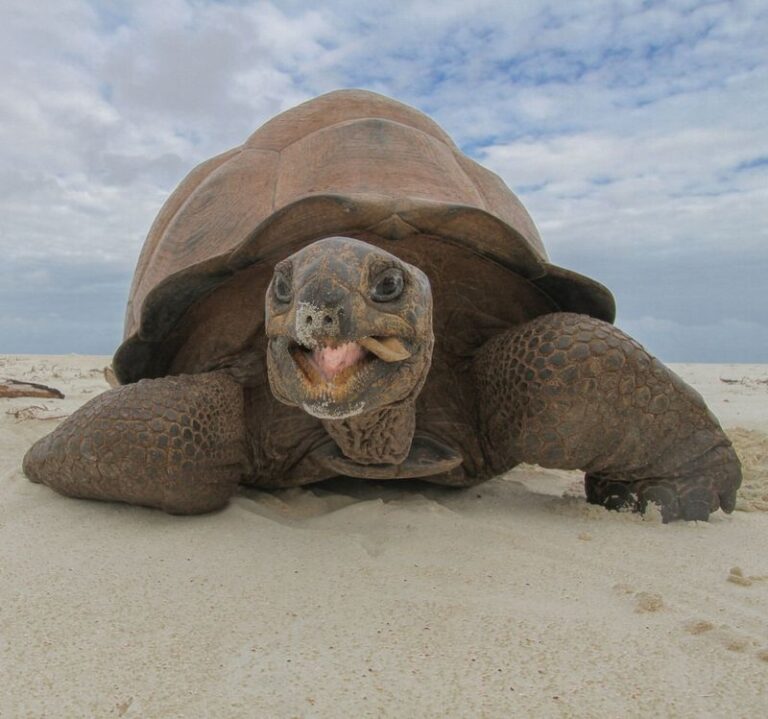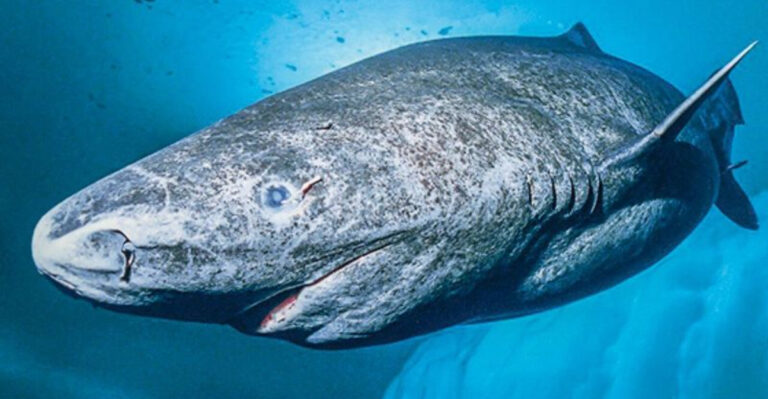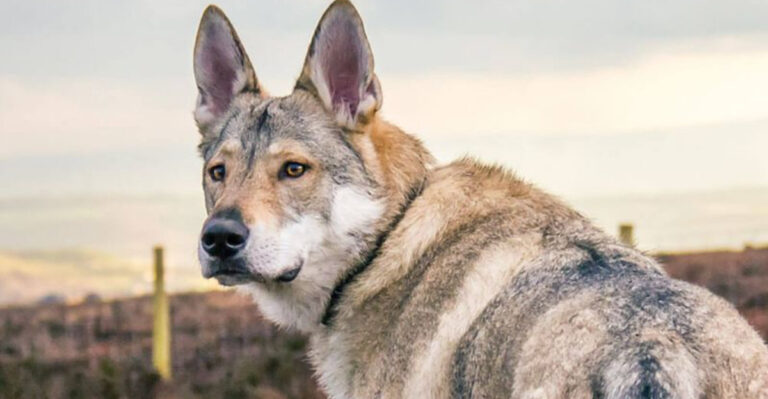21 Extinct Whale Species That Were Stranger Than Anything Alive Today
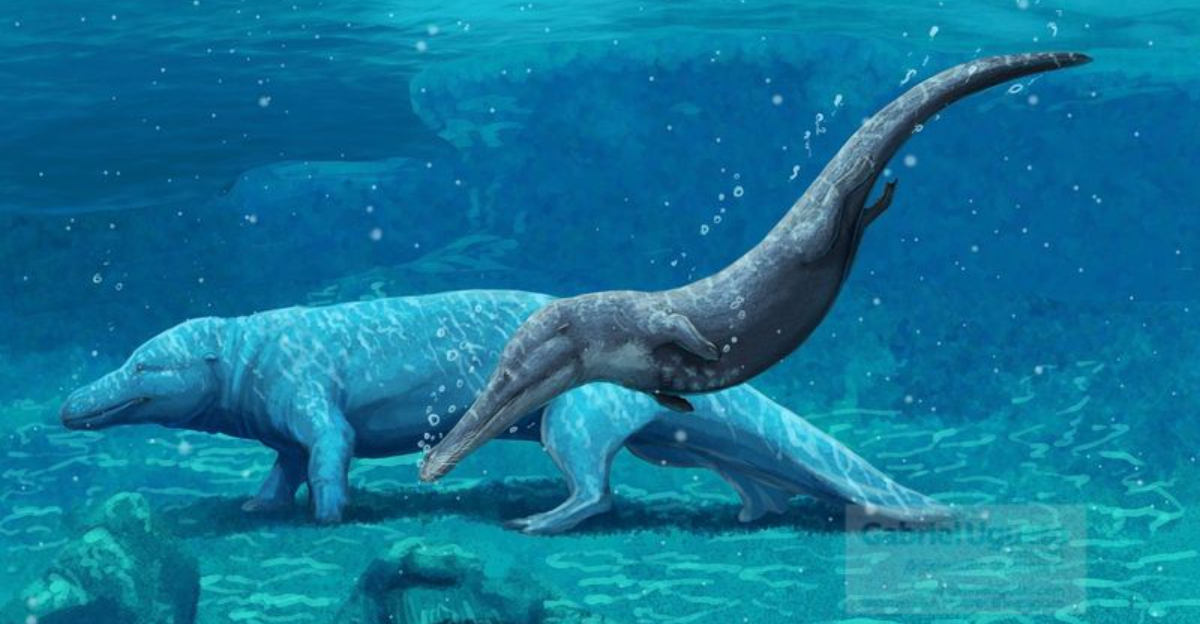
Whales are some of the most fascinating creatures in the ocean today, but millions of years ago, their ancestors were even more bizarre. From whale-like creatures with teeth to species with unique body structures, these extinct whales defied the norms of marine life.
In this article, we’ll explore 21 of the most unusual extinct whale species, showcasing how evolution once shaped creatures that were stranger than anything alive in the oceans today. Get ready to dive into the deep history of these fascinating giants!
1. Basilosaurus

Basilosaurus, a mammalian marine predator from the late Eocene, resembled a giant sea serpent, growing over 50 feet long. It had sharp teeth for catching fish and smaller marine mammals, making it a top predator.
Despite its serpentine appearance, its name, meaning “king lizard,” reflects its long vertebrae and vestigial hind limbs, possibly used for mating or stabilization.
Fossils found in North America and northern Africa show its wide range. Basilosaurus highlights the evolutionary shift from land mammals to fully aquatic life forms.
2. Leviathan Melvillei
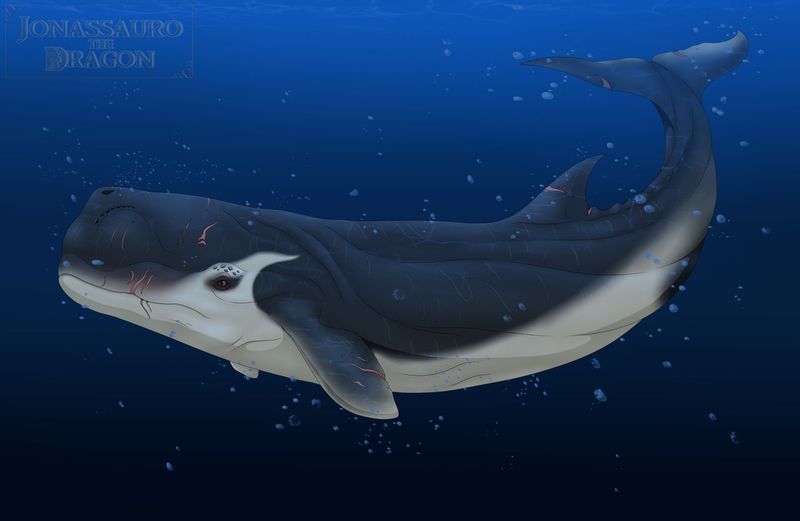
Leviathan melvillei, a massive prehistoric whale, lived around 12-13 million years ago during the Miocene epoch.
Named after Herman Melville, it had a skull over 3 meters long and teeth larger than a modern orca’s, making it a top predator. This sperm whale likely preyed on other whales, using its powerful jaw to crush bones.
Fossils found in Peru reveal its role in ancient seas alongside predators like Megalodon. Leviathan melvillei’s discovery offers a fascinating look at the fierce marine ecosystems of the past.
3. Zygophyseter
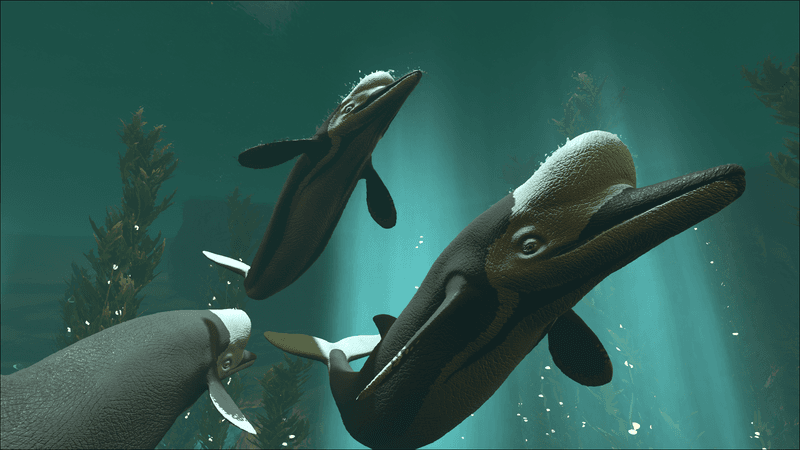
Zygophyseter, the “yoke-bearer sperm whale,” lived around 7 million years ago during the Late Miocene. This medium-sized predator, resembling a modern killer whale, had large conical teeth and likely hunted fish and smaller mammals near the ocean’s surface.
Its Y-shaped jaw structure set it apart from other whales. Fossils found in Italy offer insights into its hunting behavior and role in the Miocene ecosystem. Zygophyseter’s adaptation to ancient seas highlights the diverse evolution of early cetaceans.
4. Cetotherium
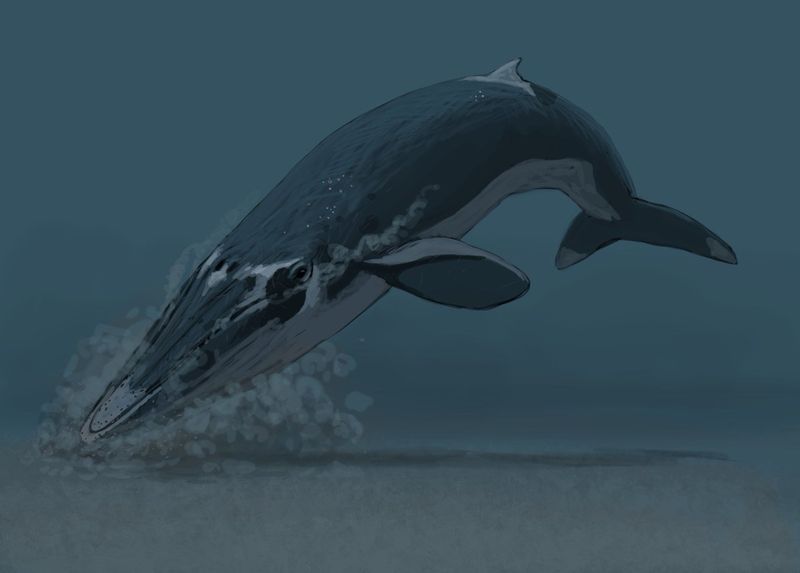
Cetotherium, a small baleen whale, lived during the Miocene and Pliocene epochs, around 15 to 3 million years ago. Reaching about 15 feet in length, it played a vital role as a filter feeder, sifting through water to consume small organisms like krill and plankton.
Its unique skull structure supported its feeding method, similar to modern baleen whales. Fossils found across Europe, Asia, and North America show its widespread distribution and adaptability. Cetotherium provides important insights into the early evolution of filter-feeding cetaceans.
5. Ambulocetus
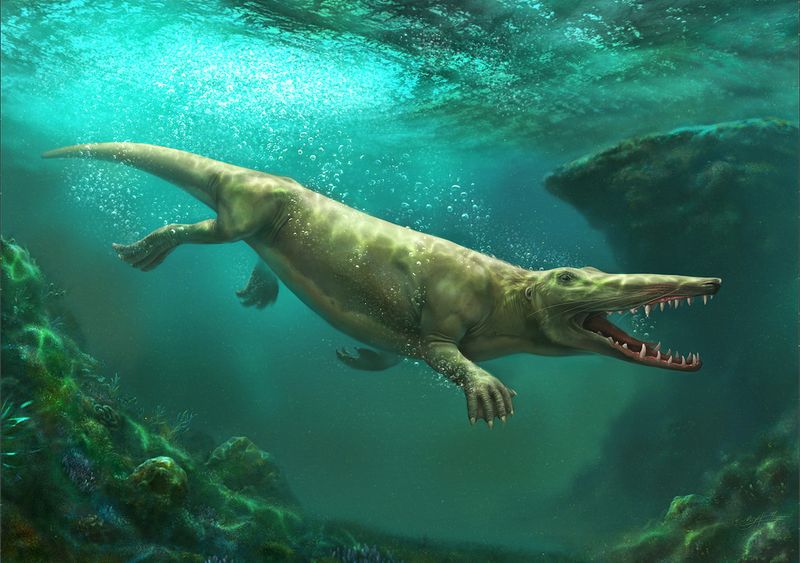
Ambulocetus, known as the “walking whale,” lived around 50 million years ago during the Eocene epoch. This early cetacean had limbs suited for both walking and swimming, marking a key transition from land mammals to whales.
About the size of a modern sea lion, it likely ambushed prey near the water’s edge. Fossils found in Pakistan provide crucial insights into the evolutionary journey from land to sea. Ambulocetus illustrates the gradual adaptations that led to fully aquatic whales.
6. Dorudon
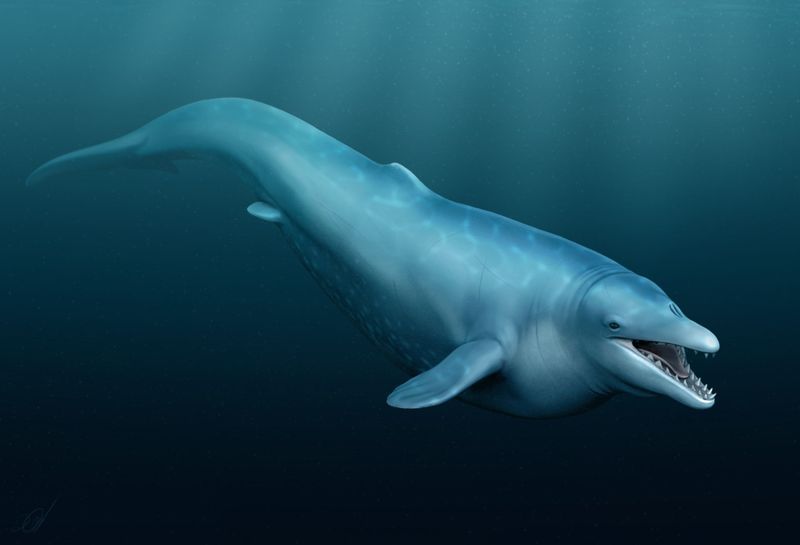
Dorudon, a smaller relative of Basilosaurus, lived around 41 to 33 million years ago during the late Eocene. Measuring about 16 feet, it provides key insights into whale evolution. With a streamlined body like modern dolphins, Dorudon had sharp teeth, suggesting a diet of fish and squid.
Its features, such as echolocation and deep diving abilities, link it to modern whales. Fossils found in Egypt and North America show its widespread presence, helping paleontologists trace the evolution from land mammals to modern whales.
7. Pakicetus
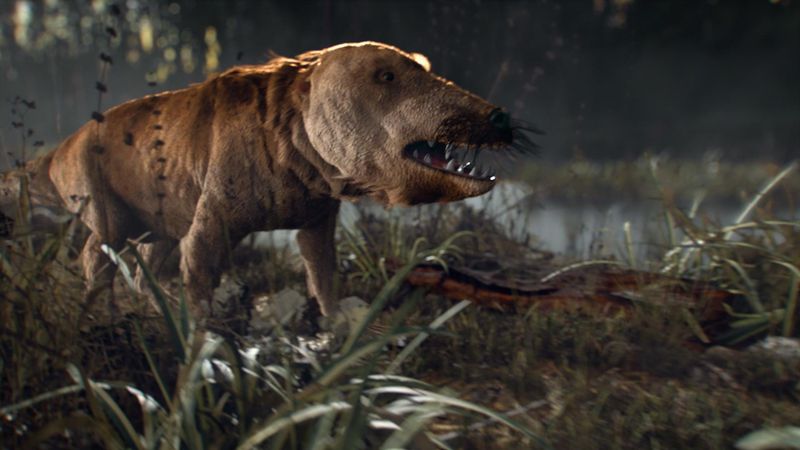
Pakicetus, often regarded as one of the earliest whale ancestors, lived around 50 million years ago during the Eocene epoch in what is now Pakistan. It resembled a small, wolf-like mammal and was adapted for both land and water.
While its body structure suggests a terrestrial lifestyle, its teeth and ear bone adaptations indicate a gradual shift toward aquatic environments.
The discovery of Pakicetus fossils was groundbreaking, offering valuable insights into the land-to-sea transition in whale evolution. Pakicetus marks the beginning of the extraordinary journey from land mammal to ocean giant.
8. Squalodon
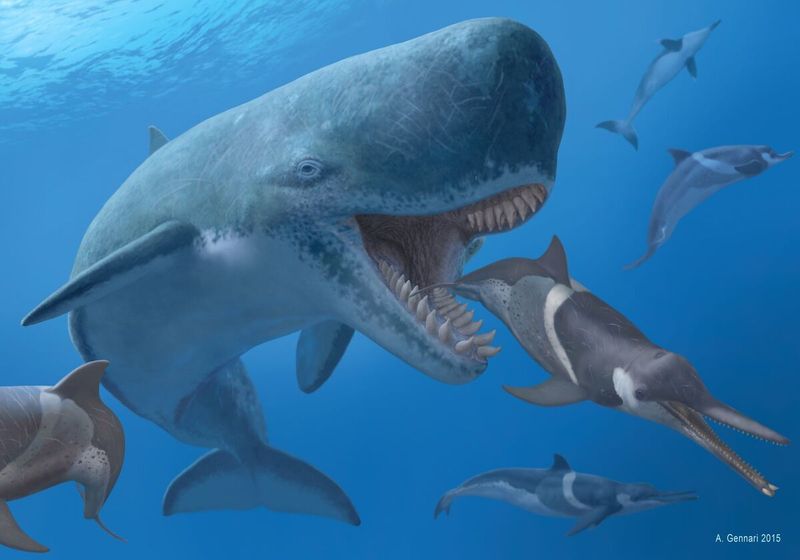
Squalodon, a key link between ancient whales and modern toothed whales, lived between 33 and 14 million years ago. This 10-foot-long whale had a streamlined body and conical teeth suited for grasping fish, resembling modern dolphins and porpoises.
Its distinctive elongated snout suggests early experimentation in whale head morphology. Fossils found in Europe and North America shed light on the spread and diversity of early toothed whales.
Squalodon’s existence helps trace the evolutionary path toward modern odontocetes and their advanced echolocation abilities.
9. Aetiocetus
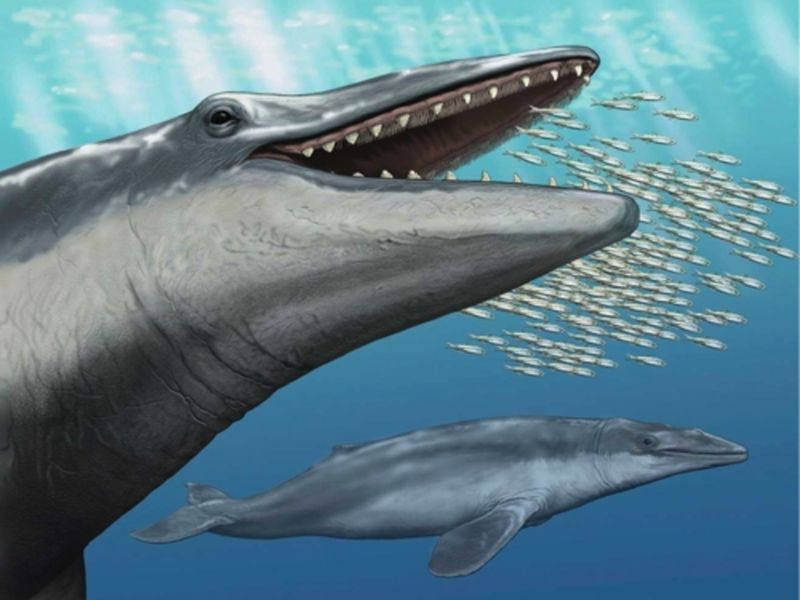
Aetiocetus, an important link in baleen whale evolution, lived around 25 million years ago during the Oligocene epoch in what is now the Pacific Northwest. Unlike modern baleen whales, Aetiocetus had both teeth and baleen plates, suggesting a transitional feeding strategy.
It likely used its teeth to grasp prey and its baleen to filter small organisms. Fossils of Aetiocetus offer crucial insights into the origins of baleen whales and their filter-feeding mechanisms, highlighting the adaptability and evolutionary innovations that paved the way for today’s giant whales.
10. Toothed Mysticete
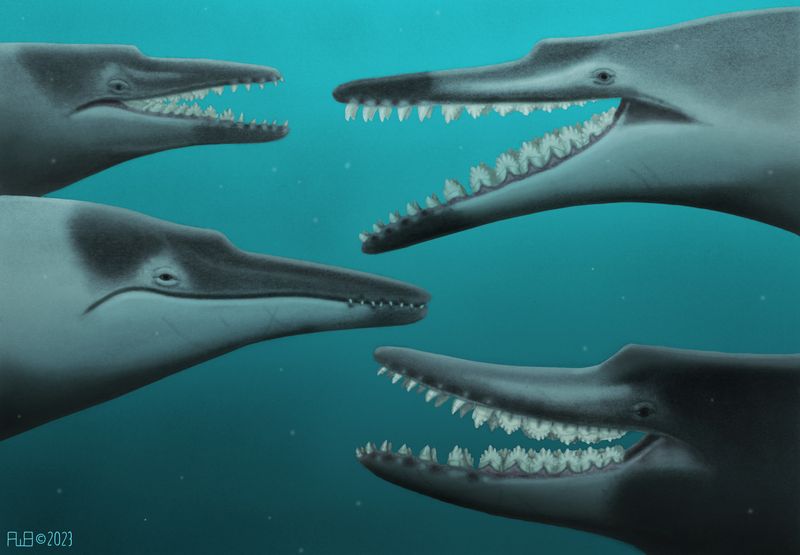
The Toothed Mysticete, existing around 28 to 23 million years ago during the Oligocene, represents an evolutionary stage between toothed and baleen whales. These whales had both teeth and early baleen, enabling them to catch prey with their teeth and filter small organisms with baleen plates.
Fossils of Toothed Mysticetes, found in ancient ocean habitats, shed light on the transition from one feeding strategy to another. Their dual feeding mechanism highlights the adaptations that led to the development of modern baleen whales and the diverse marine environments they thrive in.
11. Remingtonocetus
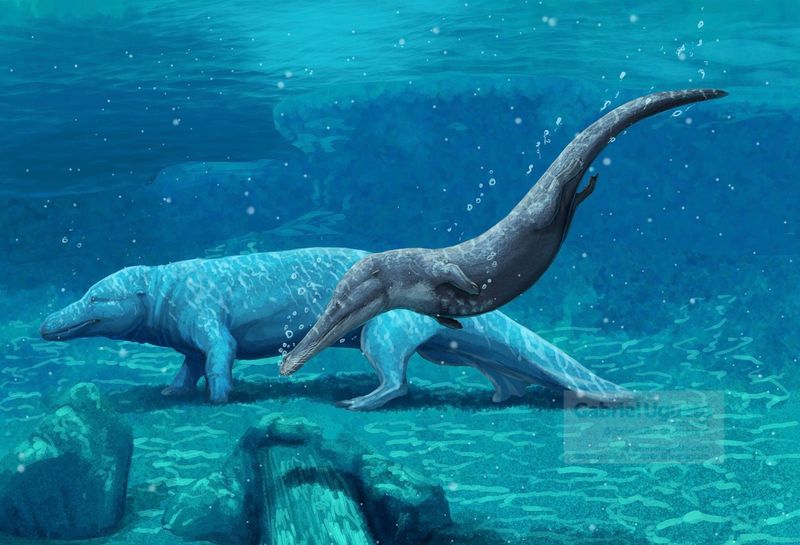
Remingtonocetus, an early whale from around 49 million years ago during the Eocene, represents a transitional phase in whale evolution. With its long snout and sharp teeth, it was adapted for catching fish and other prey near ancient shorelines.
Its body design suggests it could swim and move on land, reflecting the dual capabilities of early cetaceans. Fossils discovered in India and Pakistan offer insight into the habitats these whales inhabited.
The combination of terrestrial and aquatic traits in Remingtonocetus deepens our understanding of how early whales evolved to thrive in diverse ecological niches, leading to fully marine cetaceans.
12. Maiacetus
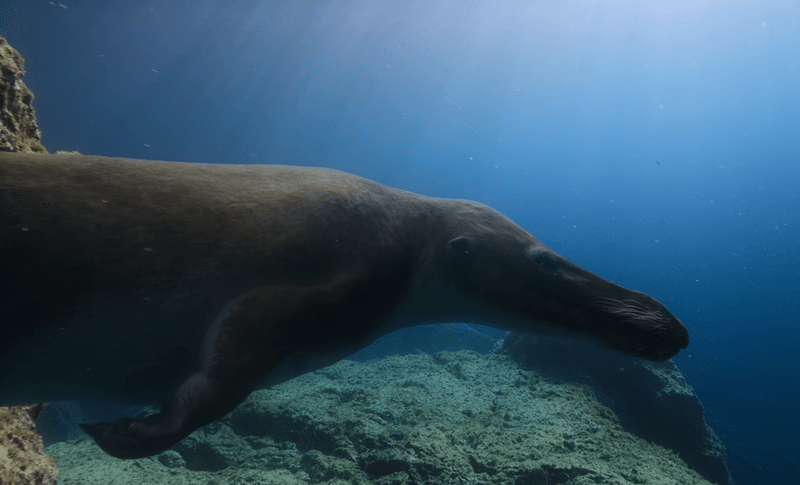
Maiacetus, known as the “mother whale,” lived around 47 million years ago during the Eocene. This amphibious creature had webbed feet for swimming and limbs for movement on land, reflecting the transition from land to aquatic life.
Fossils, including a pregnant female, found in Pakistan, provided insights into early whale reproductive biology and their dual lifestyle. Maiacetus remains crucial in understanding whale evolution, bridging the gap between land mammals and fully aquatic cetaceans
13. Rodhocetus
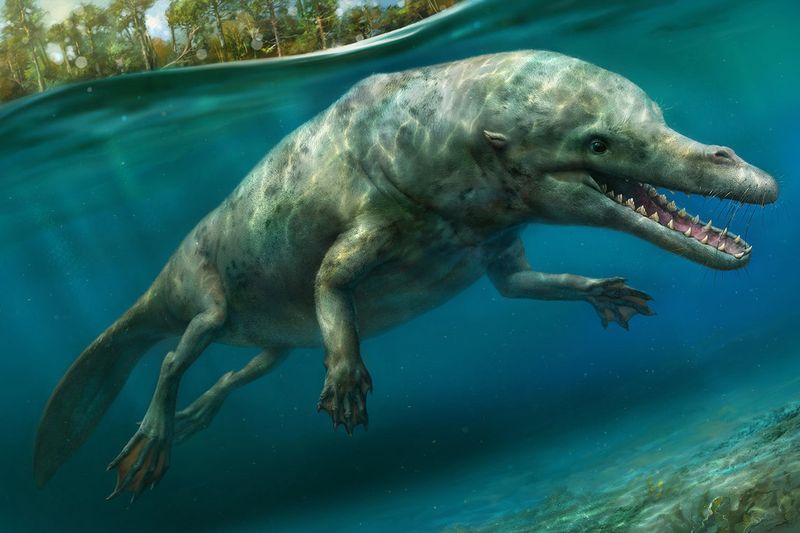
Rodhocetus, an early whale from the Eocene, lived around 47 to 40 million years ago and shows the gradual transition from land to sea. With limbs adapted for both swimming and land movement, it exemplifies early whale adaptation.
Fossils discovered in Pakistan reveal how these creatures became effective predators in ancient seas, highlighting the evolutionary steps that led land mammals to become ocean giants.
14. Protocetus
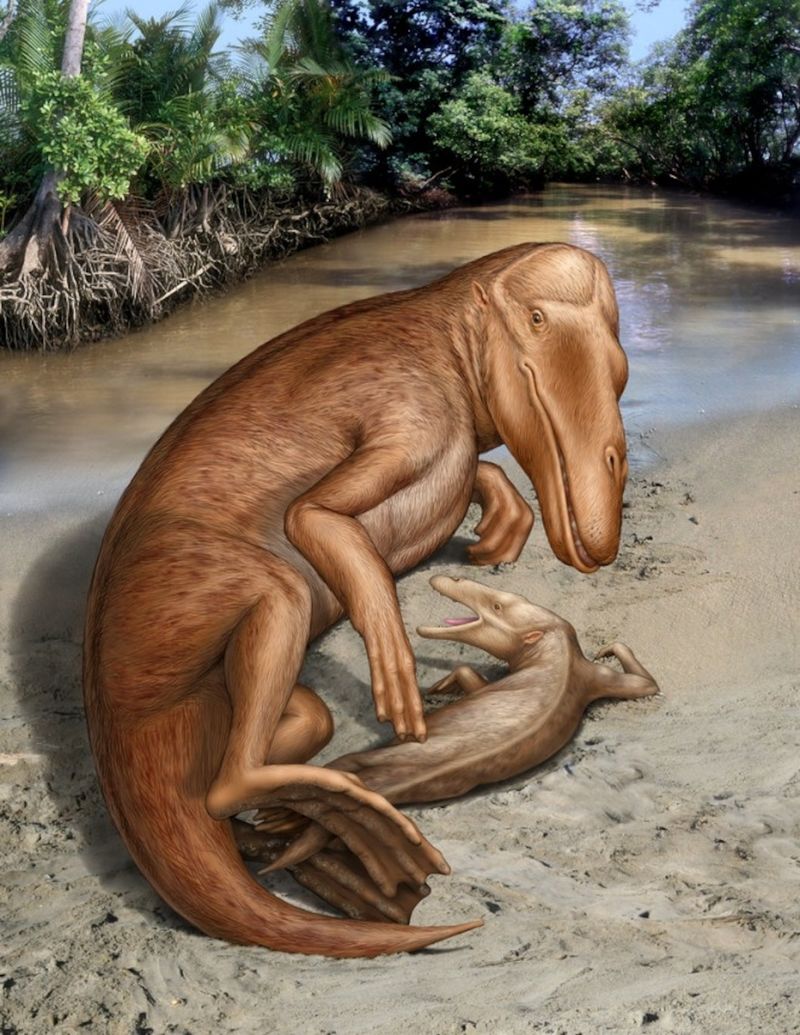
Protocetus, from the Eocene epoch, lived around 48 to 40 million years ago, showcasing the transition from land to sea. It had a streamlined body and limbs suited for both swimming and occasional movement on land.
Fossils found in shallow seas offer insights into how Protocetus adapted to marine life while retaining some terrestrial features, marking a significant milestone in the evolution of cetaceans.
15. Georgiacetus

Georgiacetus, from the late Eocene, lived around 41 to 34 million years ago and shows the transition from land to aquatic life. With a streamlined body and powerful limbs, it was an adept swimmer yet retained some land-based features.
Fossils found in North America offer key insights into the gradual adaptations that allowed early whales to thrive in the ocean.
16. Aegicetus
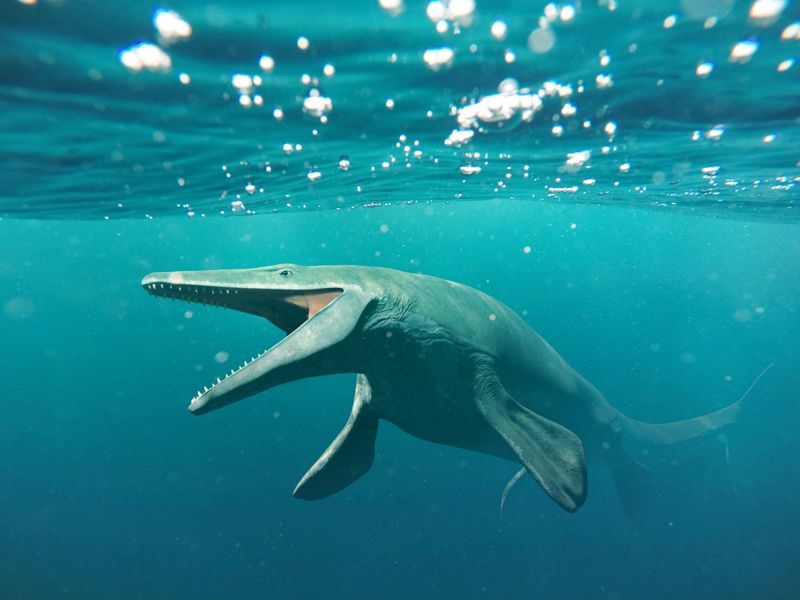
Aegicetus, an early whale from the late Eocene, lived around 40 to 35 million years ago. Its elongated body and limbs were suited for marine life, but it still retained some terrestrial traits.
Fossils found in ancient seas reveal the evolutionary pressures that shaped early cetaceans and their transition to fully aquatic life.
17. Mystacodon
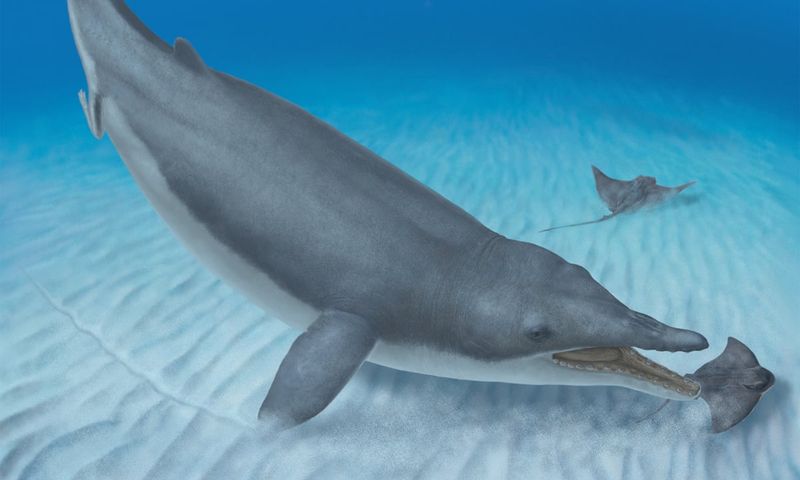
Mystacodon, a transitional baleen whale from 36 million years ago, had vestigial teeth alongside early baleen, showing the shift toward filter-feeding.
Fossils discovered in Peru provide insights into the evolution of baleen whales and the adaptation to marine ecosystems, bridging the gap between toothed ancestors and modern filter-feeders.
18. Parapontoporia
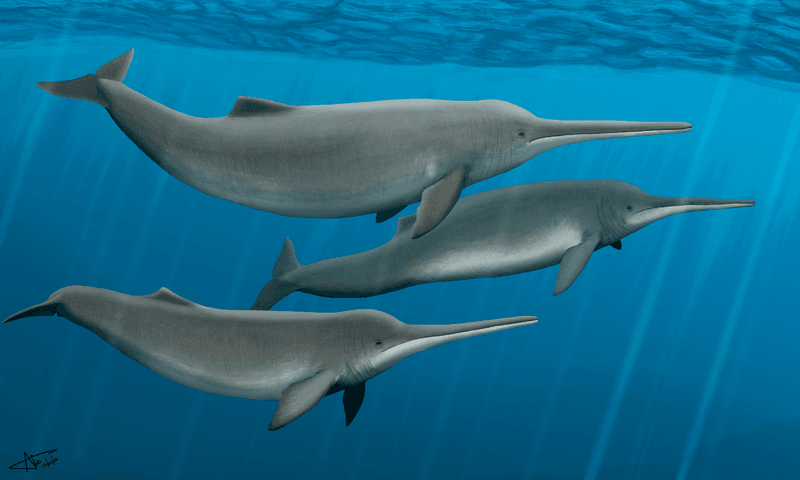
Parapontoporia, a small, dolphin-like whale from the late Miocene to Pliocene, had conical teeth and a streamlined body, suggesting a predatory lifestyle.
Fossils of this genus showcase the diversity and adaptability of early cetaceans, shedding light on the evolutionary steps leading to modern dolphins and porpoises.
19. Janjucetus

Janjucetus stood out with its unique, triangular teeth, more like those of carnivorous mammals than modern whales. This smaller predator, about the size of a modern living room, was agile in the water, hunting fish with precision.
Unlike its larger contemporaries, Janjucetus’s compact form allowed for nimble movements in its marine environment. Despite its fierce appearance, it adapted to survive in an evolving world, leaving behind a remarkable evolutionary legacy.
20. Kekenodon
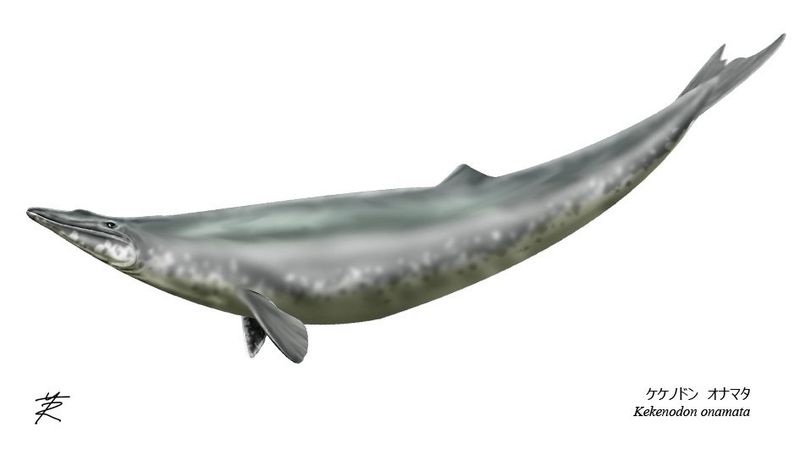
Kekenodon, an early whale from the Miocene, lived about 23 to 18 million years ago. This species had a large, robust body and was a predator of marine mammals.
Fossils found in New Zealand provide insights into early cetaceans that were evolving to become the large marine predators we are familiar with today.
21. Zygorhiza

Zygorhiza, a genus of prehistoric whales from the Eocene epoch (about 40 to 34 million years ago), was one of the first fully aquatic cetaceans.
It had a streamlined body and was closely related to Basilosaurus. Fossils found in North America highlight the shift from land-based mammals to aquatic life.


